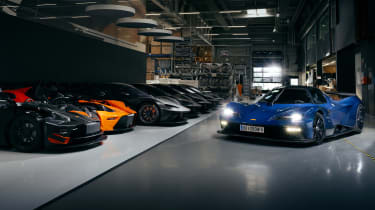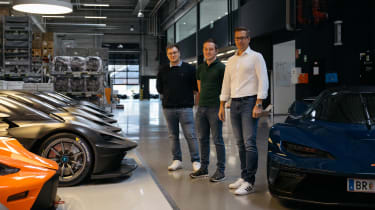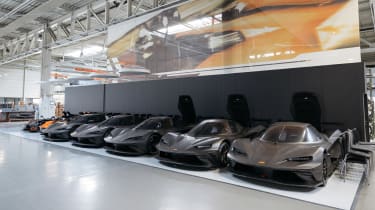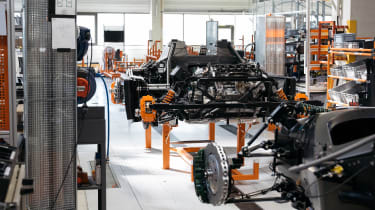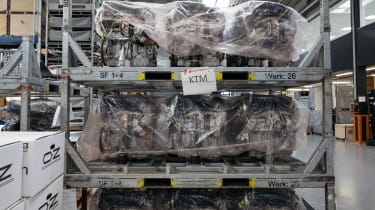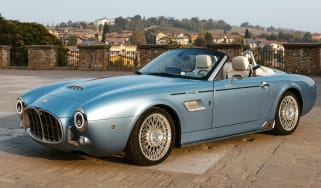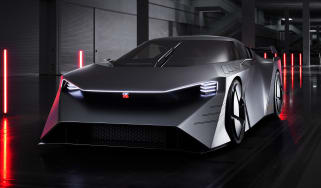KTM's reboot – the future of the Austrian marque
Why KTM’s sports car division has had to reinvent itself as a supercar maker – and how it’s paying off
Quite a big place, KTM Sportcar GmbH’s factory in Graz, Austria. Bigger, in fact, than it needed to be. Back when the X‑Bow sports car was first devised, there were visions of building 500 to 1000 cars a year. Since its launch in 2008, only a little over 1500 X‑Bows have been sold globally.
Not the numbers envisaged originally, but the open-cockpit, carbon-chassis X‑Bow has made its mark on the automotive world, finding customers in 40 countries – and made KTM a marque known for cars as well as motorcycles.
‘The original idea started in 2006, when our CEO, Mr Stefan Pierer, together with head of design Gerald Kiska, decided on an after-work beer,’ says KTM Sportcar MD Michael Woelfling. ‘Sketching ideas on a little sheet of paper, the dream was to build their own car, as radical as the motorcycles, in terms of performance and purity.’ He motions at an original X‑Bow on display. ‘It was a different world in 2008…’
Launching in the midst of a recession was a tough start for the X‑Bow, but the automotive landscape in 2008 was a more open playground in terms of emissions homologation rules. In 2014, the four-cylinder Audi turbo engine used to power the X‑Bow ended series production. ‘This was not an issue; we had a lifetime demand for many engines,’ Woelfling explains. ‘The issue was simply that the engine was not state-of-the-art any more in terms of homologation. We didn’t have the emission strategy for the engine, which can only be issued by the engine OEM. And Audi told us at that time, “Well, honestly, we won’t go for a strategy for this old engine any more. We’re sorry.” So we thought, “Okay… for a small series manufacturer like we are, what can we do?” Luckily, our board was committed to us, even through the financial crisis and so on. They told us, the [sports car] product will play into our product marketing; it extends our KTM family base; it’s a marketing tool that pays into the brand.’
So began a new chapter for KTM’s car division, a relatively tiny element in the KTM Group (which includes multiple major motorcycle companies, component suppliers and the Kiska design agency, among other assets). With support from the top assured, Woelfling’s team went back to the drawing board. The result is the fearsome X‑Bow GT‑XR, driven in evo 310. Designed as an international GT racing car as well as a fully homologated road car, it’s a more grown-up product in every sense: in size, in price, in power, in cylinder count (adopting Audi’s aluminium-block 2.5-litre five-cylinder turbo unit) and in positioning.

‘Everybody knew the X‑Bow was good on the racetrack but, optically, it was a little, tiny go-kart next to other supercars,’ says Woelfling. ‘Now, dimensionally, you can place it next to a Ferrari or a Lamborghini, and with the way the cabin opens [a motorised canopy, lifting the roof and glasshouse away from the cockpit], people want to throw away their wing-door supercars.’ It’s priced accordingly: where the original X‑Bow cost around £45,000 in 2008, the GT‑XR costs more than £300k. And rather than aiming to build 1000 cars per annum, the business model has been reshaped to a maximum of 100, highly personalised, GT‑XRs a year.
Production is ramping up as we take a tour around the factory floor, product manager Lukas Barth our guide. The first customer cars have been delivered, and a steady run of cars are taking shape on the spotless production line, a caterpillar track taking the monocoque (built and supplied by Carbotech in Salzburg) through ten assembly stations as it morphs from rolling chassis to entire car. Once the ramp-up phase is complete, a car’s complete build process will take around two and a half days.
Although the car division is separate from KTM’s bike businesses, with its own management, purchasing and R&D operations, the companies within the group do help each other out. For example, the GT‑XR’s tail lamp units are composed of Husqvarna bike lamps: ‘Creating lights for cars can cost huge money,’ Barth says. ‘We took all of the motorcycle light units within the group and put them on the designer’s desk at Kiska – he came up with this.’ Barth hands us a neat, distinctive lamp unit, Husky lights embedded in a carbon shrouding. Elsewhere, an F1 component supplier owned by KTM 3D-prints parts for the car’s canopy mechanism.
The luxury of space at the factory means all storage is in-house – shelves of Brembo brakes, Wavetrac differentials and high-end suspension components, like a kind of supersports IKEA. There is a second base some distance away, concentrating on motorsport, and KTM Sportcar management splits its time between there and the production and R&D base here in Graz (only a few streets from the factory where engineering and manufacturing giant Magna Steyr builds the Mercedes G-class).
The old X‑Bow took around 180 hours to build; the GT‑XR takes closer to 1600 hours. Customisation is key to KTM’s new low-numbers, high-end strategy: customers are invited to see their car in-build and choose from all manner of handmade finishes, from bare carbon to opaque paint and the exact percentage of tint in between. Some customers have requested two cars in different finishes.
There’s no single-vehicle approval here: GT‑XR production is fully type-approved, meaning it can be sold in any market in Europe. While there’s no right-hand-drive provision at the moment (‘It would double our costs; and we figured there’s a potential market, all in all, of about 60 to 70 cars,’ Woelfling says, ‘but let’s see; never say never’), it is possible for UK customers to order a car directly from the factory.
Being classified as a small-series product, the X‑Bow isn’t subject to real-world emissions testing, nor required to run petrol particulate filters as volume production cars do. But what of the future, though? Will KTM be starting electric vehicle design studies sometime soon?
‘We are always thinking about what we can do next but, right now, we are concentrating on fulfilling the customer orders we have for the next two and half years, and with our limited budget we are not thinking of a fully electric version of the X‑Bow,’ Woelfling says. ‘Our focus is to look at possibilities maybe with e-fuels, or other alternatives.
‘We have to look carefully at what motorsport brings in the next few years, because it may become mandatory to have a hybrid system in the car – we are working on that.’ He makes the point that fuel consumption is one of the small, light, efficiently engined X‑Bow GTX race car’s strengths, and that overall automotive emissions include particulates from tyres, brakes and more, beyond exhaust emissions and fuel consumption alone. ‘I would even count us as the “green ones” in motorsport at the moment,’ he adds.
Being a small company gives KTM the luxury of being shielded to some extent from other regulatory challenges: ‘We are a part of ESCA, the European Small Volume Car Alliance, with others like Pagani, Koenigsegg, Rimac, which gives us a united voice in Brussels. That helps us regarding exceptions for us in the future, for example around EU7 [emissions regulations], so we’ll be able to get our cars homologated on the public roads in future.
‘To tell you the truth, we are receiving phone calls from prospects asking us, “When will you stop doing serious business? And when will you stop with a combustion engine, like all the others?” And when we say, “No, we’re still keeping on,” they say, “Glad to hear that.” That is the reaction from our customers: “We are so proud of you, that you keep the flag flying and go your own way.” Now, we see it [electrification] for urban areas, on the two-wheel side. Of course, that will be the future, for short distances, but not for cars. That isn’t our strategy.’
He continues: ‘Our government is starting to rethink [its position] on no combustion engines from 2035: “Should we really run into this wall without a Plan B? Okay, let’s talk about a Plan B.” This is something we can feel right now, even from what ESCA is telling us in Brussels, that there will be some exemptions for us in the future. And this is what we are counting on.’
Near the factory’s entrance, a GT‑XR sits cheek by carbonfibre jowl with an original X‑Bow. It’s been quite a metamorphosis, in every sense – and for the company’s approach, too. ‘I’m quite proud of the journey with this car so far,’ says Woelfling. ‘I’ve been here since the very beginning in 2008, and I never expected it [to go in this direction]: from an open-top, near-Formula 3 car without any driving comfort, and now driving this.’
It’s an evolution that appears to have been the right step for the business: Barth believes the optimum annual worldwide production for small-scale sports cars to be around 300 cars – and that includes Caterham, BAC, Radical and so on. And the GT‑XR is now sold out until the end of 2025.
‘With our limited budget, we always try to reach the maximum out of it,’ Woelfling concludes. ‘We’re looking into what the future might bring, and we recognise there will be challenging times. But we’re always thinking. And we never give up.’
This story was first featured in evo issue 312.
